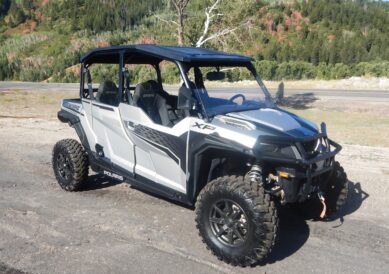A fly rod review: Orvis vs. Winston
Lately, I’ve been looking for the best 9-foot, 5-weight fly rod.
From the Sage One to the Scott Radian, I’ve had the opportunity to fish with the industry-leading rods. I’ve been looking for a rod that will toss small dries with subtle precision, but also turn around and cast streamers into a Wyoming headwind.
Through my research, both on the water and off, I whittled down my top two choices to the Orvis Helios 2 tip-flex model and the Winston Boron III X.
For the past month, I’ve fished the Orvis and Winston rods on all of my fishing trips, and I’ve finally determined which 9-foot, 5-weight is the best (at least for me) in today’s market.
Orvis Helios 2 (tip-flex)
The Orvis Helios 2 tip-flex model is a continuation of Orvis’ successful Helios line of fly rods. My first impression of the Helios 2 was just how light it is. At 2.5 ounces, it feels nearly weightless in hand. It felt lighter than the Boron III X (B3X), which weighs just slightly more at 2 5/8 ounces.
The Helios 2 is a gorgeous rod, and it’s built right here in the United States. It has a deep blue finish that shimmers in direct sunlight, with a blued burled wood insert in a skeletonized reel seat. Orvis opted to put an oversized stripping guide on the rod, a design quirk I don’t love, but it’s not a dealbreaker aesthetically.
So how does it perform?
The Helios 2 is a fun rod to fish. It’s light, lively and responsive. The rod generates higher line speeds than the Winston, on account of the Orvis having a much faster action. The Helios 2 feels a lot like the Sage One, but with a far more sensitive tip section.
That tip section helps the Helios 2 protect light tippets, a must for fishing finicky tailwaters here in the West. The rod also has a surprising amount of backbone, and I was able to turn large fish away from snags and moss in the river when I needed to.
However, the rod had a harder time turning over heavier rigs. Large hoppers and big nymphs were harder to control and cast when using the Orvis, but it still wasn’t a terrible experience.
The Helios 2 was able to lay dry flies down with delicacy, but it wasn’t quite as accurate as I would have liked. That may be more on my casting ability than the rod, however — I’m certainly not the best fly caster.
In the end, those are the only two things I could find fault with in Orvis’ latest offering. The Helios 2 is a blast to fish, looks great and performs very well. You can’t ask for much more than that from a fly rod.
Winston Boron III X
The Winston B3X is the updated version of Winston’s Boron II line of rods. Hand-built in Twin Bridges, Montana, the build quality of the B3X is superior to the Helios 2 — but only just.
Winston has long been the standard in the fly-rod industry for build quality, so it’s no surprise the B3X is so well-made.
The usual Winston emerald finish, burled wood and beautiful cork are present on this rod. The green finish is glossy, and looks great both in and out of direct sunlight. For the fishermen who enjoy a good-looking rod, the B3X will certainly stand out. There isn’t a single design aspect on this Winston rod that I don’t like.
But here’s where things get really good: The rod fishes better than it looks.
Although the rod is faster than most previous Winston offerings, it still maintains that distinct “Winston feel” that has set the company apart from others in the industry.
The rod still isn’t “fast” by industry standards; in fact, it errs more toward the medium part of the spectrum. As mentioned above, the line speeds on the B3X aren’t as quick as some faster rods, but that’s the tradeoff you make in order to get a superb dry-fly rod.
The tip section on the B3X is incredibly sensitive. Any bump on the line or fly is felt by the fisherman, and the tip helps to lay out line softly on the water. For fishing dries, there’s not a better rod aside from bamboo, or high-end glass, that can beat a Winston.
The rod does struggle, as did the Helios 2, with throwing larger flies. However, I felt that the B3X performed better in the wind than Orvis. That may be due to my casting style more than anything else, but it’s worth noting.
All in all, the Winston B3X is an incredible rod and deserves the attention of anyone looking for a new 9-foot, 5-weight.
Who wins?
This is tough. I loved both rods immensely, but when it came down to it, I enjoyed the Winston more than the Orvis.
I tend to fish more small dry flies, so the B3X’s ability to lay them out with uncanny softness on any water surface was the big draw for me. Honestly, though, both rods are excellent and I found myself fishing them equally for the past month. They’re just so much fun to use.
Your casting style will largely determine which of these two rods you buy.
The Helios 2 can be bought for $725; the B3X will set you back $795. Orvis offers a 25-year warranty; Winston’s is a lifetime.
Spencer Durrant is a writer and fly fisherman based in Utah. He writes the monthly Trout Bum column for the Standard-Examiner, and contributes regularly to Hatch Magazine. If he’s not on the river, he’s at home tying flies or writing. Connect him on Twitter, @Spencer_Durrant.







